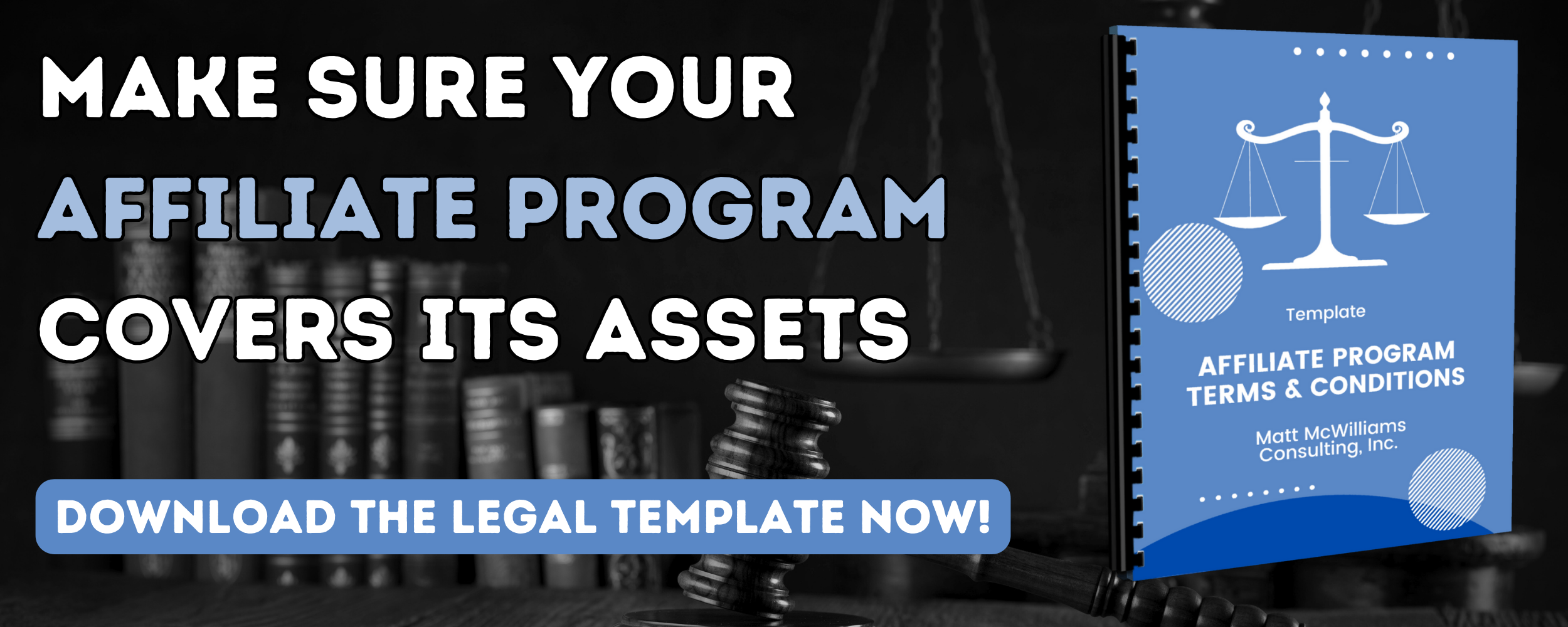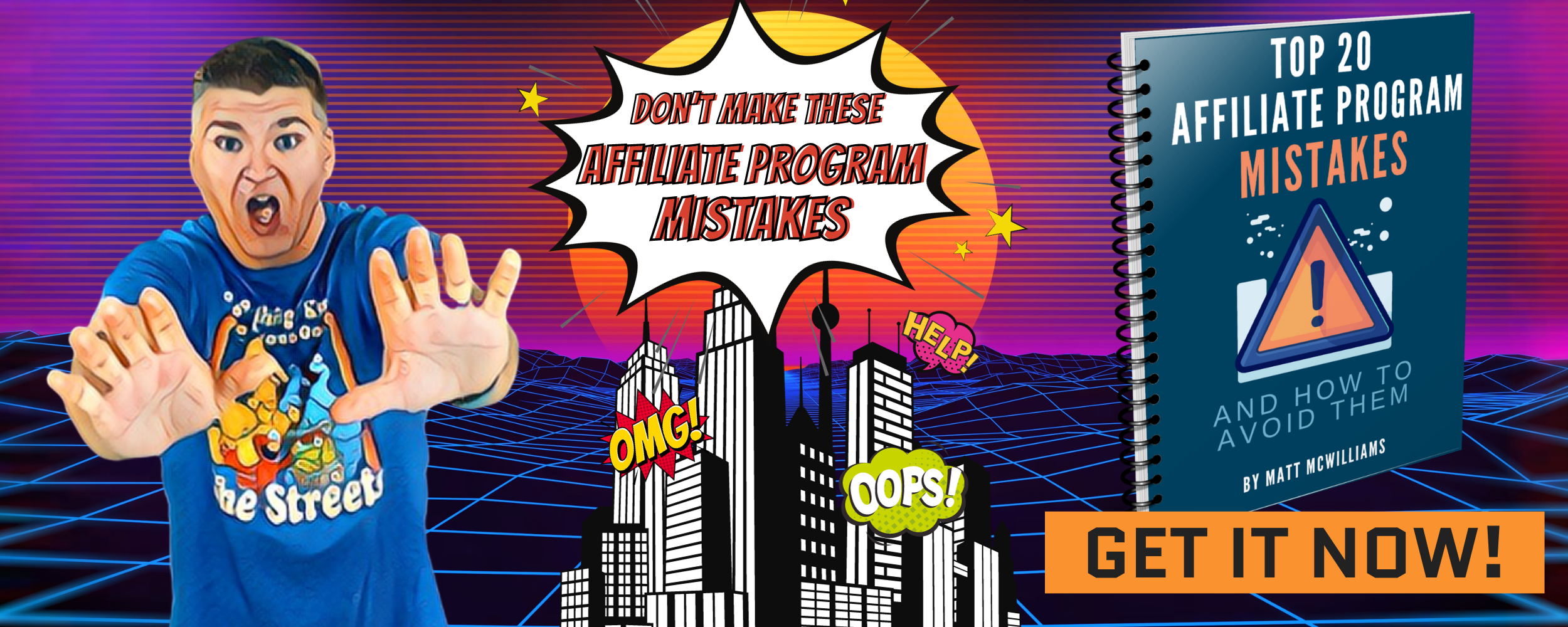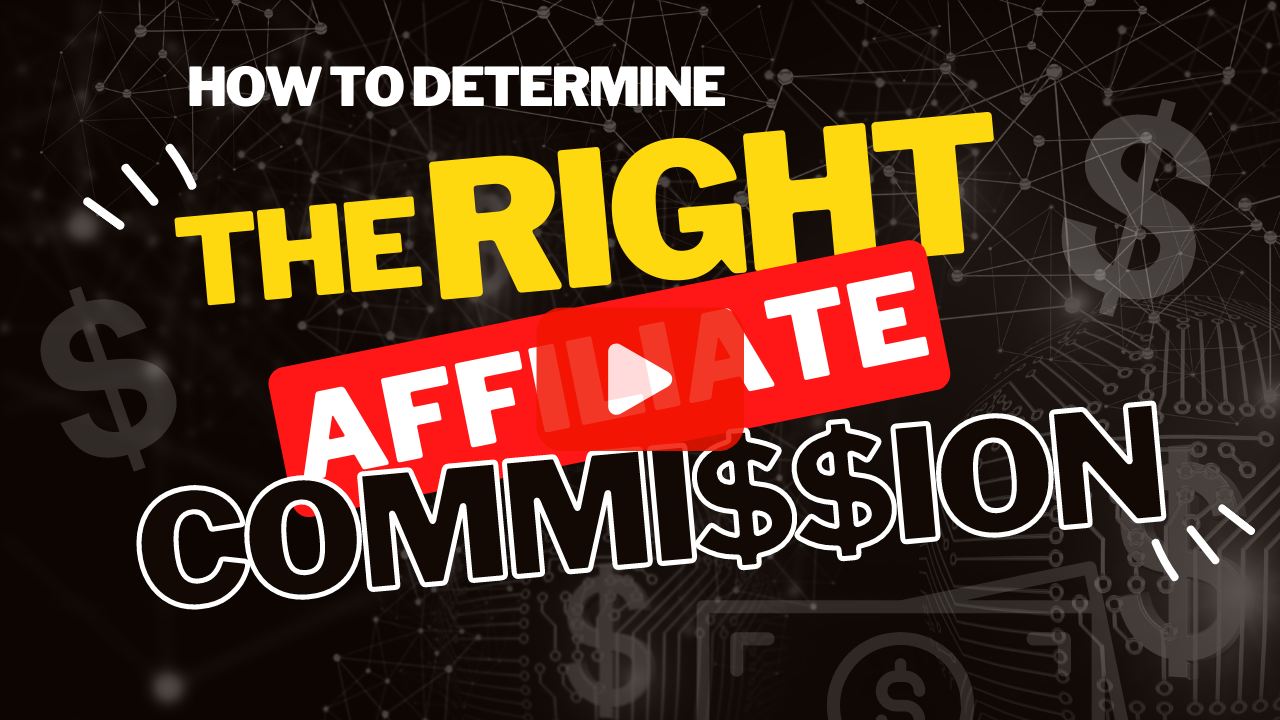When I started my first affiliate program, I learned a lot through trial and error…and some huge mistakes, I built a $1 million/month affiliate program in the next two years. Some of those mistakes almost destroyed our business. The GOOD news for you is that I’m sharing those mistakes in this episode, so YOU don’t have to make them!
Click Here for The Written Transcript of This Episode
Listen to Part Two Here
Don’t Miss An Episode – Subscribe Below
Links/Resources Mentioned in This Episode
Top 20 Affiliate Program Mistakes (and How to Avoid Them)
My #1 Affiliate Recruiting Email
How to Determine Commission Structure
Facebook Live: The BIGGEST Lie You’ve Been Told About Finding Affiliates
TEXT ME – +1 260-217-4619
Previous Episodes of The Affiliate Guy
WORST Affiliate Email I’ve Ever Received
Easy Way to Get an Extra 10% from Your Affiliates
How Brenda Ster Did a $90,000 Affiliate Promo With Just 1200 People
The 6 Pillars of Every Great Affiliate Program (Pillars #4-6)
The 6 Pillars of a Great Affiliate Program (Part Three)
Don’t Make These Killer Mistakes with Your Affiliate Program (Part 1)
When I started my first affiliate program back in 2005, I literally knew nothing about how to run an affiliate program. But through a lot of trial and error and some huge mistakes, I built a $12. 6 million affiliate program over the next two years.
Now, some of these mistakes were nearly fatal to our affiliate program and our whole business at the time. Now, the good news for you though, is you don’t have to make the same mistakes I did. In today’s episode, I’m going to share the first of 20 huge mistakes I made in those early years of my affiliate program. So you don’t have to make them.
So in our last episode, I shared why I was wrong about when to start an affiliate program and go back and listen to that. If you haven’t yet, it gives you some of the thinking behind why I taught what I taught for so many years, and also kind of the evolution of that thinking. Again, what I taught about when to start an affiliate program was right for some people.
It really was. If you’re running a seven figure business and you don’t have an affiliate program, what I teach is right. But if you’re just getting started, what I was teaching was wrong and I’ve rethought that and I think you should start right now.
You should start an affiliate program right now. I don’t want to hear from people, oh, one day I’ll have an affiliate program. One day I’ll be ready. No, you won’t start now. Like start right now. And there’s these advantages that you get.
You get to make money before you spend it. It’s infinitely scalable. You get to bring in leads and grow your list and start making money now, even when you’re first starting out, you don’t have to guess at targeting and try to go spend thousands of dollars with Mark Zuckerberg, just trying to make a little money before he lets you be profitable.
You bring in these warm prospects and it grows itself. Like Success begets success with an affiliate program. And so I hope that that episode, and I hope today, if you’re not already convinced, to convince you of two things, that an affiliate program is the best way to grow your sales and the best way to start, build and grow an affiliate program is to learn from others, to model others, to learn today from my
mistakes, because I sure as heck have made a lot of them. And the beauty of this is I made a lot of them. In fact, we had to trim this down to 20 because I could have kept going for a while.
The beauty of it for me was these were mistakes that I made back in 2005, early 2006, I got to make those mistakes and I didn’t have to pay a huge consequence for that. And so I was able to learn, I was able to keep going. Our business survived and in fact thrived.
We built a $12. 6 million affiliate program over the next two years, an $18 million business. We were the third largest, largest company in our entire niche. The largest privately held company in our entire niche. And it was a big niche.
Insurance leads. And so we were doing awesome because I got to screw up and not have to pay the price. I will say that these are mistakes you cannot make today.
Some of these mistakes that I made that weren’t really that big of a deal or they certainly weren’t fatal. They stung, they hurt, they cost us 5000, 10,000, $25,000. They weren’t crippling our business and destroying our affiliate program.
You make these same mistakes today. They might. And I don’t say that to scare you. I say that’s why I want to share them with you. You don’t have to make any of these 20 mistakes. How cool is that?
I’m going to literally go through and share all of the ways that I possibly could have screwed up. And you don’t have to make any of these mistakes. You get to do these right from the get go.
So let’s jump right in. Let us jump right in with mistake number one, by the way, this is a two part series. I’m going to release a part two here in a few days because if I shared all 20, this would be like a two hour podcast.
I don’t know. I don’t know how long it’ll be. I haven’t recorded it yet, but it would be really long. So we’re breaking it down into two parts. All right, you guys ready? Are you ready?
No, I can’t really see you right now. So I’m not recording this live or anything. So I don’t get any feedback. So I hope you’re ready to dive right in or it’s weird that you listen this far anyway. All right. Mistake number one is that we waited too long to start it.
We waited until we were desperate. And if you know anything about sales or business, that is not the best time to start anything. The best time to start a business is not when you need to start a business. Right? The best time to start is when you’ve got a full time job. That’s why I tell people, like, don’t leave your full time job.
Run your side hustle. And the cool thing about that is, let’s say you make $60,000 a year from your job and only 20 from your side hustle. Then you can take all 20 of that and set it aside. And after three years, you have an entire year’s worth of income stored up. So don’t quit your job. But we waited too long to start it.
We tried a bunch of other stuff first instead of just starting our affiliate program. Now, part of that was, again, back then, I didn’t know about affiliate programs. None of us did.
I heard about it randomly from someplace and it was like, oh, we should do this. Very few companies and none of our competitors had an affiliate program back then. But it’s not just us.
And it definitely wasn’t back, just back in 2005. There’s a guy, I’ll share this story. I’m going to call him Fred because you’ve heard of him. Okay. He’s been on the Ted stage, like the main stage, not the X stage, right. He’s been on the Ted stage.
He’s written probably four or five bestselling books. Six figure email list, seven figure business, close to eight figure. I’m going to go with probably $6 million a year business.
I met him about three and a half, four years ago and he said, I don’t need an affiliate program. He’s like, man, I’m running Facebook ads and they are killing it. We’re making like 80 90% of their revenue was from Facebook ads.
Now the irony of this is that this guy had built his empire in part on telling people to diversify their incomes through things like investing and real estate. All these things. Right?
And that’s about all I’m going to say about him because then you might figure out who it is. And I don’t want to do that. I think I’ve been vague enough.
And yet he was putting all of his marketing eggs into the Facebook basket. Now, thankfully, he had a CMO, a chief marketing officer, who is a pretty smart dude. This guy tried to talk him into starting an affiliate program, but he would not listen. What I say Fred. I think it was Fred. Yeah, Fred wouldn’t listen.
Then four months later, four months after we first met. So this was about almost four years ago that we met about three and a half years ago, this happened. Facebook shut their account down, their ad account down.
And it’s funny, because I just had a call with a Facebook ads expert. She was just saying, yeah, it happens all the time. Ours has never been shut down.
She’s like, that’s why you should have a second ads account with the pixel running and all that stuff, so your account doesn’t get shut. If it does get shut down, you’ve got the backup, right? It took them a week to get the ads account back up.
Hours and hours of dealing with Facebook. A full week with nearly no revenue, no leads coming in. Basically, their entire business was almost. I mean, he’s talking about shutdowns, right? Their business was almost shut down. When they came back, their CPC rates, their cost per click rates more than doubled.
Their ad costs more than doubled, and they went from nearly 100% profit margin. They went from spending, like, $100 to acquire $2,000 customer down to it costing. Their margins were astronomically higher, because not only did their CPC rates go up and their ad costs went up, but their click rates and their actual.
The amount of times that their ads showed went down dramatically. So, literally, they went from making, let’s just say, about $500,000 a month and spending less than $50,000 a month to spending more than double. So, like, spending 125,000 and they were making, like, 250.
Again, this is a big business with a big team. That’s a dramatic difference. So their next call to me was to me, of course. And as you can imagine, my rates doubled. But the thing is, I was like, yeah, I’m not trying to gouge you, but I tried to give you a deal last time and get you in, and you said no. So here’s.
We’re going to go back to charging what we normally charge. Well, the thing is, these nightmare scenarios are, like I said, they’re very just. I just was talking with Andrea Vowell.
She’s a Facebook ads expert. And she’s like, yeah, this happens all the time. And so there’s this lie out there that says that you can do everything that you want in your business alone.
Like, you don’t need help from anyone. You can reach everyone on earth through Facebook and Google, maybe LinkedIn right now. Those. I get it. Those platforms are huge. Instagram’s huge.
TikTok’s getting huge. But I am telling you that you’re missing out on all the benefits. All those benefits. We just talked about the scalability, no risk, because you make money before you spend it. The easy targeting, all those benefits that we talked about, the warm prospects.
And so simply put, when you don’t have an affiliate program, you put a very low ceiling on your growth. That was one of the biggest mistakes that we made. We waited way too long to start. So start now. Plan on starting right now. Like start laying the groundwork.
Let’s get you an affiliate program up and running in the next couple of weeks. That should be your goal. I promise you it’ll be best investment you ever make in your business.
So we did eventually start, we waited way too long and then we actually started reaching out to affiliates and we made my second mistake. I say we made my second mistake. We didn’t make this mistake. I did. I keep saying we. Yes, it was a business. I had two business partners, but it was me. I screwed this up. So I’m going to take ownership of this.
I sent way too long of a first message. Sent way too long of a first message. Now that means when I’m trying to find affiliates and recruit them, I would send these long verbose emails, like 610 paragraphs long.
It’s got all the details and the stats and there’s a link in there and it’s like, oh my gosh, this email went on and on. I don’t know these people. I didn’t know anybody in the industry.
That was the other thing. I didn’t have any connections in the industry. I knew no one. And I’m reaching out to them cold and I’m saying, hey, do you want to be an affiliate of our program? Here’s why it’s great. It’s the best affiliate program on the face of the earth. And we pay this and here’s our conversion rates. And here’s our EPC earnings per click. And here’s this link that shows this form.
And you can see this link that shows this landing page and also this link that shows this landing page. And this link that shows this landing page. And also this and this and this and oh, by the way, my favorite color is purple. And here’s some more links. And it went on and on and on. That is totally wrong.
Now why did it sort of work back then? It sort of worked because I was like the first person who ever reached out to them, maybe the second or third. Nobody was reaching out to them and saying, hey, do you want to be an affiliate for our insurance leads program or do you want to be an affiliate for any of our, any program, period.
They weren’t getting very many emails about that, so I got away with it. It does not happen now. So the key now is to make sure that you keep your initial contact short.
Keep that initial contact super short. This is hard to understand, but your goal is not to get a yes response. Like, I know that sounds weird.
Your goal is not to share everything with this prospective affiliate, not to tell them everything about how amazing your product is, how awesome your course is, how amazing your service is, how great your coaching is. And oh, by the way, here’s what so and so says about me, and Tony Robbins said this about me, and so and so uses this product and loves it. And here’s a testimonial we got from one of our raving fans yesterday.
And oh, by the way, here’s our conversion rate, our earnings per click, and we have this upsell and this feature. We have a lifetime commission. We’ll talk more about that later. We have our lifetime cookie and here’s your commissions. And oh, by the way, we have these prizes. Like that’s way too much.
Your goal is simply to inspire enough curiosity to stay right back with these three simple words. Tell me more, tell me more. Those are the three sweetest words you can read or hear that starts a conversation.
And so when they write back, and I’m going to share a link here in a moment where you can grab this template, but when they write back to this very short email, the sample email that I’ll share with you is like three or four sentences. And we’ve tweaked this over the past decade plus and it’s perfectly optimized at this point.
When they write back and say tell me more, that is permissioned for you to now write back and say, great, I would love to tell you more. Here’s a little bit about our product, our conversion rate is this. It’s for this audience. Here’s what we provide, here’s what you will make.
And that’s when you write a little bit more detailed email. And then they write back and say, oh, great, what about this? And you respond back and answer that question and give them a little bit more detail and they go, okay, I’m in. Now they say yes. Will you get, if you reach out to 100 prospective affiliates, will you get five or eight yeses from that first email? You absolutely will.
You will probably get about seven yeses, twelve to 15 no’s, about 35 no responses. And then the rest of the people are going to write back and say, I’m interested, tell me a little bit more. And that’s when you start that conversation.
And we love hearing tell me more. So if you want to get a sample email. If you want to get the email that we’ve optimized over the past twelve to 15 years and it’s super short, but it’s super effective, just go to mattmcwilliams.com/bestemail and you can grab that. My number one affiliate recruiting email. So mistake number one was I waited way too long.
Mistake number two, I sent too long of a first reach out message to these folks. Mistake number three is I thought I needed to know all of my affiliates. I thought I had to know all of them.
Make sure that your affiliate program has a solid agreement (AKA Terms & Conditions). To make things simple, grab my template here!
So that meant that I could only have a small affiliate program, 2030 affiliates. I thought that because one, I didn’t know any better, and two, I had heard kind of that’s what you wanted to do. And so what I had heard is, and we see this a lot, kind of in the big launch world is affiliate programs, JV programs, whatever you want to call them, they’re only for the cool kids with the right connections.
They’re only for the cool kids. You need to know all of your affiliates. But the reality was when I first started out, I didn’t know anyone. In fact, none of us did. Like we weren’t the cool kids, we didn’t have dads who knew the right people. We started with nothing.
And yet in two years we built a twelve and a half million dollar affiliate program. But I thought that as we got affiliates, like I had to become best friends with every single one of our affiliates, which meant that we couldn’t have any small affiliates. And we’ll talk more about that in a little bit.
But I want to share with you, we did a Facebook live recently where we shared a strategy that it’s worked for countless, worked for literally thousands of people at this point. I’m going to share an example here from a guy named Alex Putnam in a second. He went from literally like a complete nobody to an industry leader in only nine months using this strategy.
Now we shared this strategy on a Facebook Live recently. You can watch that. We’ll put this link in the show notes as well. But mattmcwilliams.com/may14, we share this strategy on this Facebook Live. We basically talk about the biggest lie that you’ve been told about finding affiliates.
And here’s what Alex said in response, not to that training, but what I taught him a while back in some coaching, he said, Matt, I just had to let you know this. When I signed up for the training, I didn’t know anyone who could be an affiliate. Yesterday we finished our first launch of the course and did $374,000 360,000 of that was from affiliates.
I’m on bleeping cloud nine right now. Thank you, thank you, thank you. And lots of exclamation points. Right? In nine months, he went from knowing no one in his niche to doing $360,000 in affiliate sales. And he didn’t know a soul before.
So can you see yourself doing this? Could you see yourself reaching out to people you don’t even know and getting them to be affiliates? Now here’s the thing. What I share on this Facebook Live, if you go check it out, and I highly recommend you do, like I said, we’ll link to it in the show notes. It actually is. It doesn’t seem so simple.
It is so simple, so obvious and so elementary that you might feel tempted to brush it off. But you know what? It’s also my company’s secret weapon. It’s been my secret weapon for more than 14 years now. Took me about a year to figure it out. And so you absolutely do not need to know all of your affiliates.
Again, we’ll talk more about this a little bit in number six, that it’s okay to not to have affiliates. You don’t even know who they are as long as you kind of monitor them. All right.
Now the flip side, number four here, the number four mistake I made, the flip side was I did not invest enough in relationships early on. I did not invest in relationships building better relationships with current affiliates and building relationships with prospective affiliates. I simply did not build those relationships.
So I was very transactional and I had a great personality. I was good on the phone, but I didn’t invest in strengthening those relationships or building relationships with people who might become affiliates. But it might be a year or two years before they finally agreed to promote.
And so the key here, the mistake that I made was not doing that. The lesson I learned over the next couple of years was invest first, then ask. Invest first, then ask with the big ones.
So the strategy I share in the Facebook live is not the strategy. You’re going to go out to get the industry leader in your niche to be an affiliate. That’s not going to happen.
Dollars. Okay, want to be clear on that. Will you get some small to medium sized affiliates that in total, if you look at what Alex did, brought in $360,000 in a single launch with us, brought in twelve and a half million dollars over the next two years.
Actually, it was twelve and a half million dollars in a year. In the second year is more accurate. Does it work? Yes. Is it the way to get the biggest affiliates? It’s absolutely not.
When we did that twelve and a half million dollars, we did not have the biggest affiliates. We just had an army of small to medium affiliates. Again, we’ll talk more about that in number six.
But you want to invest in those relationships. And so what I found is when you’re first starting out, a good mix, because you can’t invest in relationships for five years, just investing in relationships for five years. You have to make some money, you have to get some leads, right?
That’s not running a business if you’re just building relationships with people. So I found for me that it’s kind of a good 70 2010 mix. So what do I mean by that?
When I was starting out, 20% was spent investing in the current relationships, 10% investing in prospective relationships. So 70 2010. Now, as I’ve grown and become more experienced, that has become more like.
If I were to estimate, it’s probably more like 50 30 20 50% in new relationships, 30%. Actually it probably is more like 40 40 20 40% in new relationships, 40% in existing relationships and 20% in prospective relationships. Of course, as your affiliate program grows, the amount of time as a percentage of your time that you spend trying to get new relationships will go down compared to the amount of time you spend on your current relationships.
The good news is, while you don’t want to skimp on time on your current relationships, it is about 20 times easier in terms of time and effort to just keep a relationship than it is to get a new 120 times easier. A little bit goes a long way. A text every month or so, just checking in on them.
A congratulations email when something good happens in their lives. Basic networking. Go to my website, search networking.
You’ll find all kinds of stuff on how to actually not suck at relationships with people, how to not disappear on people for months at a time. That’s your big mistake there. Don’t make that mistake.
All right, so not investing enough in those relationships early on and building better relationships with current affiliates and prospective affiliates was a huge mistake. The next big mistake I made was a simple one. I didn’t set up the right cookie length.
Now, what do I mean by cookie length? If you don’t know, it is the length of time for which your affiliate will get credited after the initial click. So if I click to your affiliate link today and I buy 90 days from now and you get credit, but I buy on 91 and you don’t, that is a 90 day cookie.
Here’s the thing, make your cookie lifetime. I’ll explain why in a second. It’s just the easiest way to do it, and it’s the best way to do it, but I’ll explain that in more detail.
But we set it up and we didn’t know any better. And so our cookie length was 30 days. And so if somebody purchased on day 31, our affiliates didn’t get credit.
Now, there’s two reasons why that sucked. Number one, it lowered their commissions, which was bad for us, because then they were less likely to promote. Two, it looked bad.
Why is it only 30 days? Are you trying to screw us? And so we got a lot of pushback from higher rank, better affiliates on that 30 day cookie link that I didn’t know any better.
That’s what the default was when we set up the affiliate program, it was just a 30 day cookie. And so I quickly was like, dude, we need to change this to a lifetime cookie. And so we studied the numbers, and at that time, less than 3% of our transactions happened outside of 30 days.
So it wasn’t going to cost us practically anything to change this to lifetime. But now I could go around and say, we have a lifetime cookie. And we were one of the few programs not just in our niche, but overall, like, out of 10,000 affiliate programs across all these niches, we were one of like a couple dozen that had a lifetime cookie, and it gave us a competitive advantage.
We studied this a while back, and we found this is across numerous brands, across numerous niches, almost all transactions, 94%, I believe, happen within 30 days. And nobody would ever suggest you have less than a 30 day cookie. So 94% happen within 30 days.
So you’re giving up 6%, but you’re gaining so much more because you’re able to say, we have a lifetime cookie. And if that is a competitive advantage, then use it. If your competition does not have a lifetime cookie, then use that against them. Use that against them. And really talk about the fact that you have a lifetime cookie. There’s no reason not to.
Don’t make the same mistakes I’ve made with my affiliate programs. Learn my top 20 affiliate program mistakes…and how to avoid them!
It’s not only the right thing to do, in my opinion, because these affiliates work their butts off to send you traffic, to send you leads, and then you’re going to be cheap with them. We’ll talk about that in number seven. No, don’t be cheap. Just set it up. Lifetime, it’s easier. You don’t have to explain it.
And if it gets you an extra 20% of affiliates, why not? The other benefit that we found is it actually allows for the fact that occasionally you have an affiliate, they’ll make a sale nine months later, a year and a half later, maybe that affiliate stopped promoting, but suddenly they just earned $800 and you send them $800. Now, don’t just send them $800 and say nothing, send them an email that says, dude, we’re paying you $800.
Oh, my gosh. It’s so amazing. This is from something you sent a year ago and it gets them reengaged, reinterested. We’ll talk more about engagement in the next episode. Engaging your inactive affiliates. But it gets them reengaged because you just sent them money.
There is no better time to talk to them and ask them, hey, do you want to promote this next thing? We’ve got this huge thing coming up. We got a summit coming up.
We’ve got a new book coming out. We got a new product launch. We got this. We got this. After you just gave them money. So there’s that advantage as well.
And so a lot of people look at that and go, wow, I had to pay $800 to that affiliate and they haven’t even promoted in a year. I look at that and go, that’s a marketing cost. I just paid $800 to get them to send six emails in our upcoming promotion that are going to make us $40,000.
You don’t gripe that you got to keep paying Zuckerberg, you got to keep paying Facebook every time you want to run an ad. But we gripe about it when we have to pay our affiliates a little bit of a lifetime commission every now and again for something they didn’t do, just to be able to get them to promote again. Now that’s a marketing cost right there. So make sure you set up the right cookie link. Just go with lifetime. Make it easy.
Mistake number six, we’re halfway through today. Mistake number six is not working with smaller affiliates. Now, I didn’t do this because I thought, wow, we kind of had to ramp up really fast.
I need to get some bigger affiliates in and we need to have a big splash. Now, I learned this lesson really fast, that this was a terrible idea. Not for the reasons I’m going to share, but for the reasons that we couldn’t get any of the big ones.
I said earlier we built this twelve and a half million dollars plus on small and medium affiliates because that’s all we could get. But I thought initially, no, that’s not worth my time. I’m not going to work with some guy who’s bringing in $30 a week.
I’m not going to work with some guy who’s going to make like one sale a month or whatever. This is ridiculous, right? That is the wrong way to look at this.
First of all, you’re probably not going to get the big ones when you’re first starting out. So go out and get the small ones. Get the people who are like at your peer level and below or slightly above.
So if you’ve got 500 people on your list, go out and get a bunch of affiliates who have 100 to 2000 people on their list. Secondly, let me explain how this works and this applies. Even if you’re listening and you’ve actually got a pretty decent sized affiliate program or you got a pretty decent sized list, what do you got, 50,000 people on your.
What if you have 5100 thousand people on your list, you’re doing all right? I don’t want to work with small affiliates. Let me explain how this works.
It’s a numbers game. So if you have 100 affiliates that are quote unquote small, average list size of 700 people, they’re going to make an average of. On an evergreen program, they’re going to make you about one sale every four months, three a year in a launch.
They’re going to make you one sale on average, probably 1. 2 sales, something like that. They are. They’re not going to show up on a leaderboard. They’re going to send you 29 opt ins for your first plc.
They’re going to send you 37 registrations for your webinar. And that’s about what they’re going to do. They’re not going to grow your list all that much.
You’re going to be like, that’s not worth it. But of those hundred, let’s fast forward. We’ll go four years down the road, four years from now of those got out of the game, like they actually just quit so they didn’t grow.
See, I told you. Some of them even just quit. But another 30 are going to be twice as big as they were. They’re going to have 1400. So they’re going to make a sale every 40 days. Now.
Okay, when you add that up, that’s not bad, but not really like game changing. Right? When you have a launch, they’re going to make two or three sales.
They’re going to send 87 registrations for the webinar and 55 for your video series, whatever it might be. You’ll sell a few books every now and again through them. But they’re going to promote everything.
Just remember that. They’re going to promote everything. That’s one big advantage of them. So where were we? Probably about another 30 are going to triple or quadruple. Okay, now we’re really starting to talk, right?
That’s great. They’re also going to promote pretty much everything of those remaining ten. Five of them are going to five to ten x, they’re going to grow steady.
They’re going to discover some ads or some. They’re going to get their own partners. They’re going to land a few really big podcasts.
They’re going to get some exposure in a magazine. But five of them are literally going to ten to 25, to even 100 x. They’re going to hit it big.
If this had been the 90s, they landed a gig on Oprah today. They were the first to get on the new social media network and next thing you know, they woke up with 180,000 TikTok followers that they turned into 50,000 email subscribers. And then they boom, boom, boom.
And one thing after another and they had a podcast that took off, they had a YouTube channel that took off, and they’re one of the big, quote unquote big boys. Now it’s only 2345 of those original hundred, but they are loyal to you forever. They will remember that you worked with them and they were nobody I have affiliates to this day that promote my products in a completely different niche, two in particular that I can think of that I have been working with since 2007 or sooner.
They are massively large today, and they are incredibly loyal to me. So I’m going to just say it. Do not make the mistake.
I did work with the small affiliates. It may not have a great Roi today, but first of all, you probably can’t get any of the big ones when you’re first starting out. And second of all, it allows you to build that loyalty.
It’s also a great way to test things out. Do you want to go test things out with your dream affiliate? I’m going to go get my dream affiliate within three months.
First of all, it’s probably not going to happen. Second of all, if you do, it will probably backfire. But with these small affiliates, you begin to learn things.
You learn how to work with them. Most of them will stick around. Most of them, they’re not sending enough traffic anyway to know how things are converting.
So work with those small affiliates. All right, mistake number seven, I tried to be way too cheap with my commissions. Oh, my gosh, I tried to nickel and dime my affiliates.
Now, part of that was we kind of needed the nickel and the dime, but it was brutal. It was absolutely brutal. Like, we were like, I wonder if we can get away with only paying 50%.
This was in a niche where 50% was really good, but we didn’t convert as well, and it was 50% of a lower number, and so we really needed to pay 60 and 70%. And I remember thinking, well, if we pay 50%, we’re right on par with everyone else. And then it was like, wait a minute, we’re not a and b, don’t we want to stand out?
We’re the new kid on the block. We want to stand out. So let’s go get some affiliates by offering a 70% commission.
And so sure enough, we started that, and it was in January, February of 2005. In August of 2005, we changed to a 70%. We paid 70% to our top affiliates.
We advertised 60 and we could go up to 70, which there’s a bonus one for you. One of the mistakes I made was I offered everything I thought I could offer. That’s not even on my list here.
Don’t offer everything you think you can offer. Advertise a little bit lower to give yourself some wiggle room. To give a super affiliate a little bump, be like, hey, if you send 10,000 in sales this month, I’m going to bump you up to this commission level.
So that might be that. You think you can do 30. We’ll then advertise 25 and offer 30. But don’t be cheap with your commissions. I have a video. I’m going to link to it in the show notes.
It’s a video on YouTube. It’s from about three years ago, where I walk you through how to determine your commission structure. You don’t want to pay too much that you literally don’t make any money.
That would be ridiculous. You also don’t want to pay so much early on that you don’t allow yourself a little bit of room to raise it. Like we just talked about, one of the worst things you can do is lower commissions. So, yeah, it’s better off to start lower. In retrospect, I wish I’d started at. I think we started at 40 with a 50% bump.
I wish I’d started at 50 with a 60, and I could have always gone up to a 60 with a 70 there. We even had affiliates. I think we were paying, like, 80% splits just because they were interested in working with us.
They were big enough, and they brought in a lot of money. But a good commission is one of the best investments you can make. So go watch that video, we’ll link to it in the show notes.
And go watch that video on YouTube, because you definitely want to learn how to set up your commission structure the right way. Now, mistake number eight was not taking just five freaking minutes a day to analyze my affiliate data. As our company grew, this was a mistake I really didn’t make until about the six month mark.
We started getting busy. We were starting to kind of ramp up. I think we were doing, I don’t know, maybe 100,000 a month in sales. Starting to make a little bit of money. I had all these other responsibilities. We started bringing on team.
Not sure how much to pay your affiliates? Watch my free video tutorial on YouTube that walks you through step-by-step.
Next thing you know, I’m in meetings half the day, and I got really busy, and so I stopped analyzing the affiliate data. The thing is, it only takes 5 minutes a day, but it is so important. Like, you get to analyze these trends, and you get to see who’s falling off, who’s suddenly making more sales, all that stuff.
None of this is in my strength. In fact, if you can do what I did, and I hired it out when I realized, oh, my gosh, I’m not doing this, I hired it out, and then I just got, like, a quick 92nd report every day. That’s like, here’s what’s happening with the affiliates.
So you want to track things like you want to look at the data and look at what affiliates are up. Now, this might be day to day. This might be week to week, month to month.
Typically we look at all of those. If you have an evergreen program, if you’re in a launch, you want to look at who clearly promoted today but didn’t yesterday and vice versa. You want to look at who’s down.
So you want to look at like year over year data. If year over year, you’re up 10% overall. But this affiliate and this affiliate are down 30%. March over march or march and April over March and April or q one. Over q one. You want to reach out to them.
You want to look for things like that. Who’s up, who’s down, who’s got really low conversions or who’s got really high conversion, whose conversions have tanked, whose traffic just stopped completely, whose traffic ramped up. Look at all these things.
Who made their first sale, who hit a milestone. So typically, depending upon the program, our milestones are first sale, 10th sale. Again, depending upon if you make your first selling, your 10th sale on the same day, that’s not really a milestone.
We’ll look at like 100 sale. We’ll look at anything involving a comma. So you made $1,000, unless it’s $1,000 commission the first time, that would be ridiculous.
But if it’s a $50 product with a $20 commission, $1,000 is a pretty big milestone. We’ll look at any type of milestones like that that people hit. You made a sale for the 200 consecutive day. We just create those milestones. We call them etms, excuses to mail. So any opportunity we can create to reach out to an affiliate, the better.
But it just takes five, upwards of like seven or eight minutes a day. And again, if you can hire it out, hire it out. Find somebody on your team who loves the nerd on your team who loves looking at this stuff, and they can come to you and say, hey, I recommend this affiliate is down 30% year over year.
This one hasn’t made a sale in three days after making a sale every day for a month. And this one, man, their conversions are terrible. They just started two weeks ago. Their conversions are terrible. There might be something up there with them. Got it. Now I can take action on that. So that’s mistake number eight. Not just taking the simple few minutes every day to take a look at the data.
Mistake number nine was I forgot the basics as we got bigger. Now, I touched on not looking at the data. Right? That was a basic. But we started trying to get fancier with our reach outs and we started sending these glossy mailings and things like that. And those can be great.
But we forgot our basics. We didn’t rely on what was proven to work. And one of my philosophies in business that has served me very well, and anytime I get away from this, it screws me over very badly, is find what’s working.
Just identify what’s working. This is working. And this is working. And this is working. Do more of it. Find these three or four things that are working and do more of it until one of them stops working and then you add something new into the mix.
But we forgot about the basics and so don’t forget about the basics. Don’t forget about, again, reaching out to new affiliates, sending a short message. Don’t forget about investing in relationships early on and building those better relationships with your current affiliates and your prospective affiliates.
Don’t forget about the basics of just like lifetime cookie, no, we’re not going to change that. Don’t forget about the basics of working with small affiliates. As we got bigger became harder for me to work with small affiliates, and I started thinking, well, should I spend the time with them? Oh, my goodness. I knew better. I just told you all the reason.
I can come on this podcast and tell you all the reasons why you should work with small affiliates. But I was like, I don’t know if it’s worth it. I started trying to get cheap again with commissions.
And so don’t forget the basics. Find what’s working and keep doing more of it, and we’ll share more of these mistakes in the next episode, of course, and you’ll learn some more of those basics as well. And mistake number ten, our last one for today is we didn’t invite our customers to be affiliates.
OMG, really? That cost us millions of dollars in the first year. We didn’t ask the people who are going to be the best affiliates, like what better source of promotional partners than your customers right now, for some reason, this is the thing.
Almost no one we talk to actually thinks of asking their customers to promote them. So they’re just like us. I screwed this up in 2005 and six, but they’re screwing it up today and I have no idea why this is, but it’s a great source.
I don’t know why people aren’t doing it, but this is a great source of affiliates. Think about they have an intimate knowledge of your product or your service, right? They have a personal story, many times a personal success story.
They know like and trust you. They will defend you to others like you literally couldn’t ask for better promoters than your customers. So if you have a system like infusionsoft, this is really easy.
You can actually just take your customers automatically, sign them up as affiliates, just create them as referral partners, and then you just create an autoresponder campaign to 90 days after they buy or whatever, depending upon the length of your course or how long it takes for your product to be used in the most effective way. Send an autoresponder email out and say, hey, do you want to become an affiliate? Do you want to promote?
Do you want to share it with our audience and make some money? Now, depending upon your niche, you may or may not want to call them affiliates. In some niches, we actually don’t call them affiliates.
Call them partners, call them ambassadors, something like that. Just because they don’t know what the heck an affiliate is, they don’t have a clue. But even if you don’t have a CRM like Infusionsoft, just go make, you know, have an assistant go in and create links for your customers.
Or definitely if you have raving fan customers like, hey, would you like to be an ambassador, an affiliate, whatever the case may be. So don’t make that mistake. Invite your customers to become affiliates. So there you have it. My first ten. They’re at my top ten.
These are actually kind of in chronological order from the evolution of our affiliate program, which you’ll see in the next episode. I’m going to reveal the next ten mistakes now I’m also going to share how you can download these mistakes. We’re putting these into a PDF, creating it as if you’ve ever seen the eat this, not that thing from like men’s health and women’s health.
We’re creating this into a like, don’t make this mistake. Do this like a checklist to make sure that you don’t make these mistakes and that you do the right things. This PDF, I’m telling you right now, is going to be a must have for everyone starting an affiliate program.
So if you want to reserve your copy right now, just go to mattmcwilliams.com/mistakes We’ll put that in the show notes and you’re going to be the first to get this pdf. With that, you got the first ten mistakes. Think about those.
Which one of those is the biggest one for you? Which one of those is the most troubling for you? Which of those mistakes do you most connect with? Which of those mistakes do you most go? Oh my gosh, yes, that’s the one I see myself making. I’m making that. Or boy, am I glad I heard that one. Let me know. Just reach out to me on social media.
Let me know. You can go to the show notes at mattmcwilliams.com/tag341. You can grab and you leave a comment there if you want.
So with that, we’ll wrap up first ten mistakes I made with my affiliate program. Even though it ended up being amazingly successful, we’ve run some big ones over the years. These are the ways that I screwed up early on. So with that, I’ll see you in the next episode.
Questions?
Text me anytime at (260) 217-4619.
Or…check out some of my free reports to help you get on the right track:
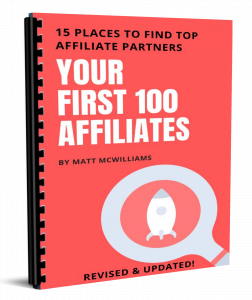 |
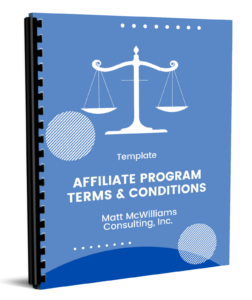 |
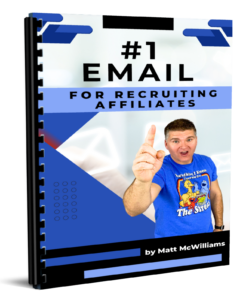 |
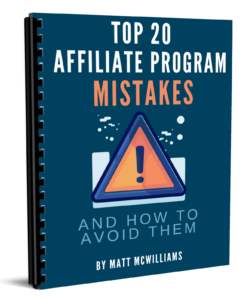 |
 |
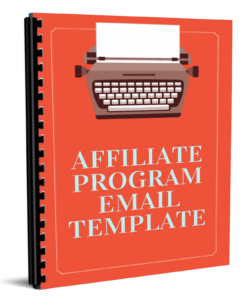 |
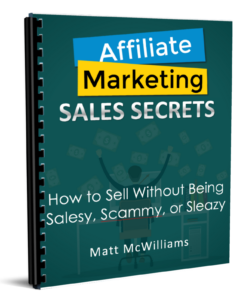 |
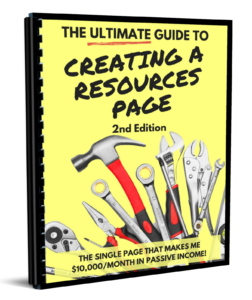 |
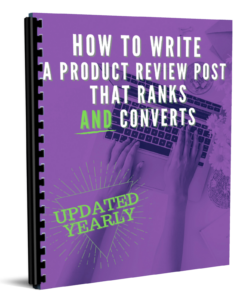 |

